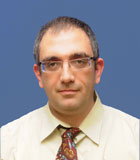Healthcare with Confidence
Leukemia is a malignant disease of the blood and bone marrow, characterized by an abnormal increase of immature white blood cells called blasts. These cells grow uncontrollably, crowding out healthy blood cells and disrupting normal bone marrow function.
Leukemia is part of a broader group of diseases that affect the blood, bone marrow, and lymphatic system. It can occur at any age, but about 90% of cases are diagnosed in adults.
In Israel, each patient is treated by a narrow-field hematologist specializing in their specific leukemia subtype. This personalized approach ensures the most effective therapy and helps improve both treatment outcomes and quality of life.
If you or your loved one has been diagnosed with leukemia, you can request an online consultation with a top Israeli hematologist-oncologist.

⇒ Leading Hematologists – Consultation Online
Types of Leukemia
Leukemia is divided into two main categories based on its progression rate:
Acute Leukemia
Acute leukemia involves the rapid proliferation of immature blood cells. The bone marrow becomes unable to produce healthy cells.
This form requires immediate treatment due to its fast progression and ability to spread to other organs. Acute leukemia is most common in children but can also occur in adults.
Chronic Leukemia
Chronic leukemia develops slowly, over months or years. It involves the accumulation of relatively mature but abnormal white blood cells.
While acute leukemia requires urgent therapy, chronic forms are sometimes monitored for a period before starting treatment to ensure optimal timing and effect. Chronic leukemia is more frequent in older adults but can occur at any age.
Classification by Cell Type
Leukemia is also classified based on the type of blood cell involved:
- Lymphoblastic (lymphocytic) leukemia — affects lymphocytes, which are part of the immune system that fights infection.
- Myeloid leukemia — affects myeloid cells that form red blood cells, platelets, and certain white blood cells.
- The combination of these two types gives four main forms:
- Acute Lymphoblastic Leukemia (ALL)
The most common leukemia in young children, but also seen in adults over 65.
Standard treatments include chemotherapy, targeted drugs, immunotherapy, and bone marrow transplantation.
In Israel, survival rates reach up to 85% in children and 50–60% in adults, and are improving with the introduction of CAR-T cell therapy for resistant ALL cases.
Chronic Lymphocytic Leukemia (CLL)
Usually affects people over 55. It progresses slowly and often does not require immediate treatment.
Israeli oncologists use targeted drugs (BTK inhibitors, BCL-2 inhibitors) that allow long-term disease control with minimal side effects.
Five-year survival exceeds 80% in Israel thanks to innovative therapies.
Acute Myeloid Leukemia (AML)
More common in adults, particularly men. Treatment includes intensive chemotherapy, targeted therapy (FLT3, IDH inhibitors), and stem cell transplantation.
In some subtypes such as APL (acute promyelocytic leukemia), modern Israeli protocols achieve over 90% remission rates.
Chronic Myeloid Leukemia (CML)
Mostly affects adults and is now considered a chronic controllable disease.
Patients in Israel are successfully treated with tyrosine kinase inhibitors (TKIs) such as Imatinib, Dasatinib, Nilotinib, and newer agents.
Five-year survival reaches over 90%.
Other Rare Types
- Hairy Cell Leukemia (HCL): Rare but manageable; survival exceeds 95%.
- T-cell Prolymphocytic Leukemia (T-PLL): Aggressive and rare; treated in specialized hematology-oncology centers.
- T-cell Leukemia related to HTLV virus: Managed with combination antiviral and immune therapies.
Causes and Risk Factors of Leukemia
Leukemia develops due to genetic mutations in bone marrow cells that disrupt normal cell growth and death.
Risk factors include:
- Exposure to radiation or carcinogenic chemicals (benzene, hair dyes, petroleum products)
- Tobacco use (linked to AML)
- Genetic predisposition and chromosomal disorders (e.g., Down syndrome, Fanconi anemia)
- Family history of blood cancers
Diagnosis of Leukemia

Diagnosis in Israel includes:
- Comprehensive blood tests (CBC, peripheral smear)
- Bone marrow aspiration and biopsy
- Cytogenetic and molecular studies (FISH, NGS)
- Flow cytometry to determine leukemia subtype
- Imaging tests (X-ray, CT, MRI, ultrasound) to assess organ involvement
Leukemia Treatment in Israel
Main Treatment Options
- Chemotherapy — remains the core therapy for most leukemia types.
- Targeted Therapy — modern drugs attack specific molecular changes in leukemia cells (e.g., Imatinib, Midostaurin, Venetoclax, Acalabrutinib).
- Immunotherapy — includes monoclonal antibodies and checkpoint inhibitors (such as Nivolumab and Pembrolizumab in certain cases).
- CAR-T Cell Therapy — available in leading centers like Sheba and Hadassah for refractory ALL and lymphoma.
- Stem Cell (Bone Marrow) Transplantation — both autologous and allogeneic; performed with high success rates in Israel’s transplant units.
New Therapies
Israel participates in global clinical trials exploring gene-editing (CRISPR) and combination therapies for resistant leukemia.
Patients have access to personalized programs based on genomic profiling and minimal residual disease (MRD) monitoring to track treatment success.
Prognosis and Quality of Life
Leukemia is now considered a treatable disease, and in many cases — curable.
While prognosis depends on the leukemia type and patient’s age, modern treatments allow long-term remission and normal life expectancy.
In Israel, comprehensive rehabilitation and psychosocial support are an integral part of care.
Why Choose Israel for Leukemia Treatment?
- Top international hematologists and oncologists
- Access to cutting-edge therapies (CAR-T, stem cell transplantation, precision medicine)
- Advanced diagnostic technologies
- High remission and survival rates
- Personalized care and short waiting times for international patients






